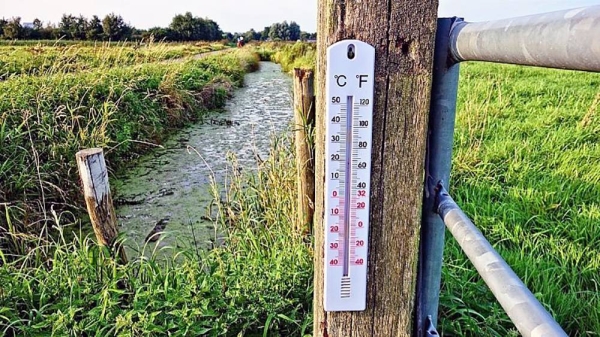
In the town of Sodankyla, Finland, the thermometer on July 17 registered a record-breaking 90 degrees, a remarkable figure given that Sodankyla is 59 miles north of the Arctic Circle, in a region known for winter snowmobiling and an abundance of reindeer.
This is a hot, strange and dangerous summer across the planet.
Greece is in mourning after scorching heat and high winds fueled wildfires that have killed more than 80 people. Japan recorded its highest temperature in history, 106 degrees, in a heat wave that killed 65 people in a week and hospitalized 22,000, shortly after catastrophic flooding killed 200.
Ouargla, Algeria, hit 124 degrees on July 5, a likely record for the continent of Africa. And the 109-degree reading in Quriyat, Oman, on June 28 amazed meteorologists because that wasn’t the day’s high temperature. That was the low . It was the hottest low temperature ever recorded on Earth.
Montreal hit 98 degrees on July 2, its warmest temperature ever measured. Canadian health officials estimate as many as 70 people died in that heat wave.
In the United States, 35 weather stations in the past month have set new marks for warm overnight temperatures. Southern California has had record heat and widespread power outages. In Yosemite Valley, which is imperiled by wildfires, park rangers have told everyone to flee.
The brutal weather has been supercharged by human-induced climate change, scientists say. Climate models for three decades have predicted exactly what the world is seeing this summer.
And they predict that it will get hotter — and that what is a record today could someday be the norm.
“The old records belong to a world that no longer exists,” said Martin Hoerling, a research meteorologist at the National Oceanic and Atmospheric Administration.
It’s not just heat. A warming world is prone to multiple types of extreme weather — heavier downpours, stronger hurricanes, longer droughts.
“You see roads melting, airplanes not being able to take off, there’s not enough water,” said Katharine Hayhoe, director of the Climate Science Center at Texas Tech University. “Climate change hits us at our Achilles’ heel. In the Southwest, it’s water availability. On the Gulf Coast, it’s hurricanes. In the East, it’s flooding. It’s exacerbating the risks we already face today.”
The proximate cause of the Northern Hemisphere bake-off is the unusual behavior of the jet stream, a wavy track of west-to-east-prevailing wind at high altitude. The jet stream controls broad weather patterns, such as high-pressure and low-pressure systems. The extent of climate change’s influence on the jet stream is an intense subject of research.
This summer, the jet stream has undulated in extreme waves that have tended to block weather systems from migrating. The result has been stagnant high-pressure and low-pressure systems with dire results, such as heat waves in some places and flooding elsewhere.
“When those waves are very big — as they have been for the past few weeks — they tend to get stuck in place,” said Jennifer Francis, a professor of atmospheric science at Rutgers University. Last year, scientists published evidence that the conditions leading up to “stuck jet streams” are becoming more common, with warming in the Arctic seen as a likely culprit.
Gone are the days when scientists drew a bright line dividing weather and climate. Now researchers can examine a weather event and estimate how much climate change had to do with causing or exacerbating it.
Last year, when Hurricane Harvey broke the record for how much rain could fall from a single storm, researchers knew climate change had been a factor.
Months later, scientists presented findings that Harvey dumped at least 15 percent more rain in Houston than it would have without global warming. Theory, meet reality: When the atmosphere is warmer, it can hold more moisture. Climate change does not cause hurricanes to spin up or thunderstorms to develop, but it can be an intensifier.
In Dallas, where the temperature hit 100 on 10 out of 11 days this month, three homeless people have died of heat-related causes in the past week, said Brenda Snitzer, executive director of the Stewpot, a downtown shelter.
In Phoenix, where this week’s temperature hit 116 degrees, Dustin Nye, 36, who spent the day installing air-conditioning units, said he has suffered heat stroke in the past and still gets woozy. “It takes a special breed to do this all day long in this heat,” he said. “You’ve really got to work up your endurance and just buckle down and deal with it.”
In Los Angeles, Marty Adams, chief operating officer of the Department of Water and Power, said, “It seems like every year, we’ve had some type of temperature anomaly that we normally would not have.” Residents of beach cities such as Long Beach and Santa Monica, who normally rely on the ocean breeze to cool their homes, have added air-conditioning units, which strains the grid and has contributed to power outages, he said.
Said Hayhoe: “The biggest myth that the largest number of people have bought into is that ‘climate change doesn’t matter to me personally.’ ”
The heat waves have hit hard where people don’t expect them — the Netherlands, Sweden, Britain, Ireland and Canada.
“Our office doesn’t have air conditioning. I do have a fan,” said Geert Jan van Oldenborgh, a climate researcher at the Royal Netherlands Meteorological Institute. He spoke by phone from the city of Gouda, where the temperature hit 96 degrees Thursday.
“This kind of event was a 1-in-100-year event in 1900,” he said. “It’s become 20 times more likely.”
It’s Britain’s driest summer since modern records began in 1961. Reservoirs are declining rapidly, and water restrictions are in effect. The United Kingdom’s national weather service urged people to avoid the sun this week, with temperatures expected to hit 98 Fahrenheit.
In Ireland, the sun-parched fields revealed a previously hidden footprint of a 5,000-year-old monument near Newgrange.
Human activity, primarily the burning of fossil fuels, has added greenhouse gases to the atmosphere, trapping heat and making extreme weather events even more extreme. The amount of carbon dioxide in the atmosphere reached 410 parts per million in May, the highest the Mauna Loa Observatory in Hawaii had measured since Charles David Keeling started keeping records in 1958. NASA estimates Earth has warmed almost one degree Celsius (1.8 degrees Fahrenheit) since the late 1800s. Of that, half a degree (around one degree F) has accrued since 1990 alone.
If nothing is done to curb greenhouse-gas emissions, scientists say, the global temperature increase could reach nine degrees Fahrenheit by the end of the century, with higher spikes on land and at high latitudes. The Paris agreement, signed by every country in the world, is designed to limit that temperature spike through commitments to cut greenhouse-gas emissions over time. President Trump, who in the past has called global warming a hoax, has vowed to pull the United States out of the accord as soon as that becomes possible, in 2020.
The 2017 National Climate Assessment, released in November, concluded what it has for nearly three decades: Human-made climate change is real, and the impacts have already started.
Average temperature is rising rapidly across the United States. Heat waves are becoming more extreme and will continue to do so.
Overall precipitation has decreased in the South and West and increased in the North and East. That trend will continue. The heaviest precipitation events will become more frequent and more extreme. Snowpack will continue to decline. Large wildfires will become even more frequent.
Kevin Trenberth, a climate scientist with the National Center for Atmospheric Research, said even modest heat from global warming can build up over time.
“The accumulated energy over one month is equivalent to a small microwave oven at full power for six minutes over every square foot of the planet,” Trenberth said. “No wonder things catch on fire.” The Washington Post












